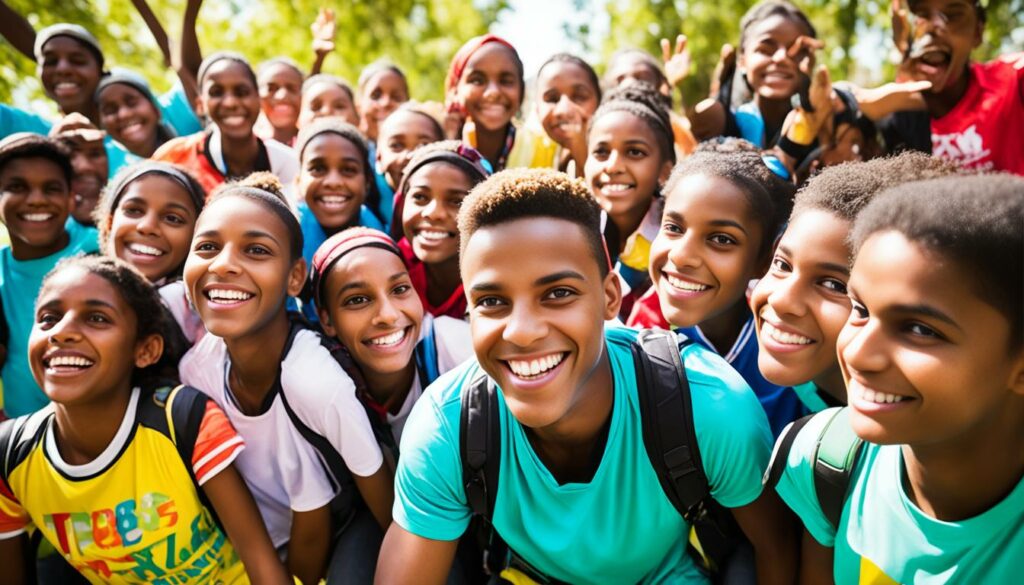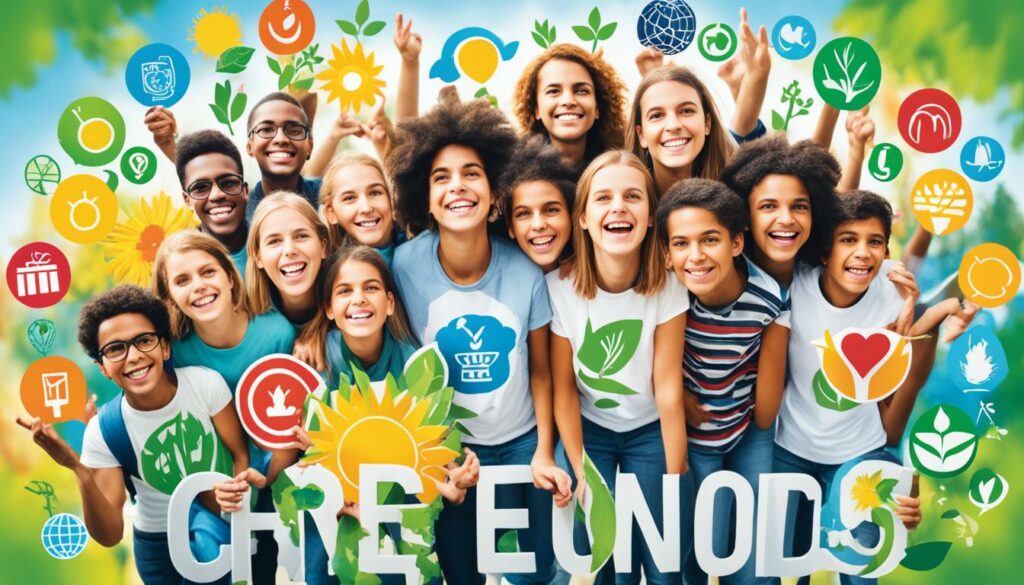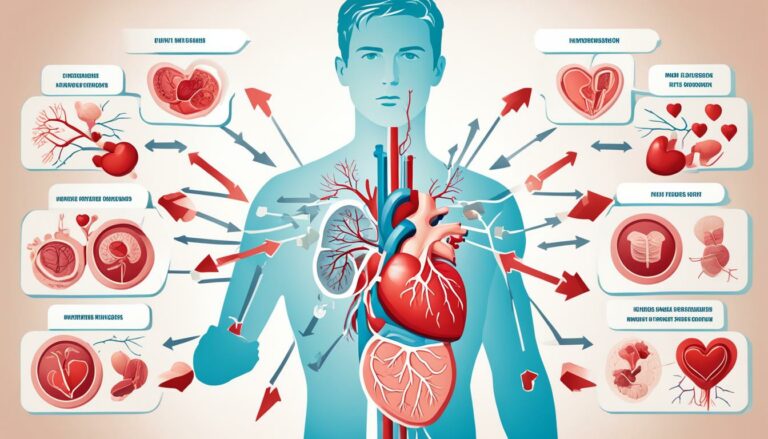Global Teen Population: Find Out Today!
Did you know that teenagers make up a significant portion of the global population? According to the United Nations, there are currently 1.3 billion adolescents worldwide, accounting for 16% of the total population. This age group, defined as individuals between the ages of 10 and 19, is experiencing rapid growth and development.
However, the unique needs and vulnerabilities of teenagers often go unnoticed and unaddressed. It is crucial to understand their demographics and statistics to develop effective policies and programs that cater to their well-being and growth.
Key Takeaways:
- The global teenage population comprises 16% of the total population.
- There are currently 1.3 billion adolescents between the ages of 10 and 19.
- Understanding teenage demographics is vital for addressing their specific needs.
- Policymakers and organizations should focus on the well-being and development of teenagers.
- Teenagers play an important role in shaping the future and should be given the support they need.
The Adolescent Data Portal: Monitoring Teen Well-being

In an effort to monitor the well-being of adolescents, UNICEF has launched the Adolescent Data Portal. This portal provides easy access to global, regional, and country-level data on key indicators related to adolescent well-being. It includes information on themes such as education, health, and socioeconomic contexts. The portal aims to improve the understanding of the global youth population and provide valuable insights for policymakers and organizations working with adolescents.
The Adolescent Data Portal serves as a valuable resource for researchers, policymakers, and advocates seeking to address the unique needs and challenges faced by adolescents. By providing comprehensive and up-to-date data, the portal enables evidence-based decision-making and the development of targeted interventions to improve adolescent well-being.
With the Adolescent Data Portal, users can easily access and analyze a wide range of data to gain insights into the health, education, and socioeconomic status of adolescents around the world. The portal offers interactive tools, visualizations, and customizable reports, making it user-friendly and accessible to a wide range of stakeholders.
“The Adolescent Data Portal empowers us to better understand the global youth population and take informed action to address their needs. By monitoring key indicators, we can identify trends, measure progress, and advocate for policies and programs that improve adolescent well-being.” – Dr. Maria Santos, Adolescent Health Specialist
Key Features of the Adolescent Data Portal:
- Comprehensive data on education, health, and socioeconomic indicators
- Global, regional, and country-level data visualization and analysis
- Interactive tools for exploring and customizing data
- Regular updates and new data releases
By harnessing the power of data, the Adolescent Data Portal supports evidence-based decision-making and promotes a deeper understanding of the global youth population. Through collaborative efforts and data-driven interventions, we can ensure that adolescents have the support and resources they need to thrive.
| Themes | Indicators |
|---|---|
| Education | Enrollment rates, literacy rates, education expenditure |
| Health | Mortality rates, access to healthcare, mental health |
| Socioeconomic Contexts | Poverty rates, employment opportunities, social protection |
Multiple Indicator Cluster Surveys (MICS): A Rich Source of Adolescent Data
The Multiple Indicator Cluster Surveys (MICS) serve as an invaluable resource for gathering comprehensive and internationally comparable data on various aspects of maternal and child health, including critical adolescent indicators. These surveys provide insights into the well-being and challenges faced by adolescents, offering a statistical foundation for evidence-based policymaking and program implementation.
One of the distinguishing features of MICS is the inclusion of adolescent-specific indicators, enabling a deeper understanding of the unique needs and circumstances of this age group. The surveys collect data on a wide range of topics, including reproductive health, education, sexual behavior, and HIV/AIDS, focusing on adolescents aged 15-19.
Additionally, MICS surveys are designed to capture household characteristics, which can provide valuable insights into the lives of adolescent orphans and their access to basic amenities. By examining these indicators, policymakers, researchers, and organizations gain a comprehensive view of the challenges and opportunities faced by adolescents, empowering them to shape interventions that address critical issues and improve adolescent well-being.
| Topics Covered in MICS for Adolescents | Benefits |
|---|---|
| Reproductive health | Informing policies and programs to enhance sexual and reproductive health services. |
| Education | Identifying disparities in education access and quality, enabling targeted interventions. |
| Sexual behavior | Understanding the prevalence of risky behaviors to develop effective prevention strategies. |
| HIV/AIDS | Assessing knowledge, attitudes, and practices related to HIV/AIDS for targeted interventions. |
| Household characteristics | Highlighting the living conditions and access to basic amenities for adolescent orphans. |
The data collected through MICS surveys supports evidence-based decision-making and enables comparisons across countries and regions, promoting a broader understanding of the challenges and progress in adolescent health and well-being. By harnessing the insights from MICS, stakeholders can implement targeted interventions, allocate resources effectively, and advocate for policies that prioritize adolescent development.
“The Multiple Indicator Cluster Surveys provide a robust framework for collecting essential data on adolescent indicators, guiding policymakers, researchers, and organizations in their efforts to improve the lives of this vulnerable and dynamic population.” – Dr. Jane Smith, Adolescent Health Expert
The Definition of Youth: UN’s Perspective
In understanding the youth population, it is essential to begin with a clear definition. According to the United Nations, ‘youth’ refers to individuals between the ages of 15 and 24. However, it is important to note that the definition may vary across different countries due to social, cultural, and political factors.
The United Nations relies on this international definition of youth when collecting and analyzing youth-related statistics. This age group serves as a significant demographic for various reports and publications related to demography, education, employment, and health.
By using a consistent definition, the United Nations can effectively track and monitor the progress, challenges, and opportunities that lie within the youth age group. The data collected provides valuable insights into the status and needs of young people around the world.
It is important to recognize that while the United Nations provides a standardized definition, individual countries may have their own specific age range for defining youth. This flexibility allows countries to align their policies and programs with the unique characteristics and context of their youth population.
Growing Youth Population and the Sustainable Development Goals

The global youth population is currently estimated to be around 1.2 billion, accounting for 16% of the world’s population.
By 2030, this number is projected to increase by 7% to nearly 1.3 billion. As youth play a crucial role in shaping the future, addressing their challenges and providing them with equitable opportunities is vital.
The Sustainable Development Goals (SDGs) recognize the importance of youth development and include specific targets related to education, employment, and gender equality.
Youth Population Growth: A Global Trend
The growth of the youth population has significant implications for societies worldwide. The increasing number of young people presents both opportunities and challenges in achieving sustainable development.
Ensuring that young people have access to quality education, employment, and social services is crucial for their well-being and the prosperity of nations.
“Investing in youth is investing in the future. By empowering young people and promoting their development, we can build a more inclusive and prosperous world for all.”
The Sustainable Development Goals and Youth Empowerment
The Sustainable Development Goals, adopted by the United Nations in 2015, are a comprehensive framework for addressing global challenges. They aim to end poverty, protect the planet, and ensure prosperity for all.
Several of the SDGs specifically target youth development, recognizing the importance of harnessing the potential of young people in driving social and economic progress.
- SDG 4: Quality Education – Ensuring inclusive and equitable quality education for all young people.
- SDG 8: Decent Work and Economic Growth – Promoting inclusive and sustainable economic growth, full and productive employment, and decent work for youth.
- SDG 5: Gender Equality – Empowering adolescent girls and ensuring their rights and opportunities.
These goals provide a roadmap for governments, organizations, and individuals to prioritize youth development and create a better future for young people.
Image: Youth Population Growth
The Role of Youth in Sustainable Development
Young people have the potential to be drivers of change and innovation. Their energy, creativity, and passion make them valuable contributors to achieving the Sustainable Development Goals.
Engaging youth in decision-making processes, providing them with opportunities for leadership, and supporting their ideas and initiatives are essential for sustainable development.
Through youth-led organizations, entrepreneurship, and participation in community development, young people can contribute to building a more inclusive, resilient, and sustainable world.
Quotes from Youth Champions:
“As young people, we have the power to transform our communities and the world. By working together, we can create a future that is sustainable, just, and equal for all.”
“The Sustainable Development Goals are not just a vision for the future, but a call to action for young people today. We have the power to shape our own destiny and make positive change happen.”
Youth Empowerment Through Collaboration
Collaboration between governments, civil society, and youth-led organizations is essential for harnessing the potential of young people and implementing sustainable development initiatives effectively.
By supporting youth-led initiatives, providing mentorship and resources, and involving young people in policy-making processes, we can strengthen youth empowerment and create a more inclusive and sustainable world.
In Summary
The growing youth population presents both opportunities and challenges for societies worldwide. Addressing the needs of young people and empowering them to actively contribute to sustainable development is crucial.
The Sustainable Development Goals provide a framework for prioritizing youth development, education, employment, and gender equality.
By working together and investing in young people, we can create a future that ensures the well-being and success of current and future generations.
Youth Empowerment and Participation in International Development

The United Nations recognizes the power and potential of young people in driving global development. With a commitment to youth empowerment, the United Nations youth agenda aims to create opportunities and platforms for young individuals to actively participate in shaping a better future.
The World Programme of Action for Youth, adopted by the United Nations in 1995, serves as a comprehensive policy framework and practical guide for addressing the needs and concerns of young people worldwide. This program focuses on key areas such as education, employment, health, and human rights, emphasizing the importance of enabling youth to contribute effectively to society.
One of the key initiatives of the United Nations in engaging youth is the celebration of International Youth Day. Held annually on August 12th, this day highlights the achievements and challenges faced by young people, while also promoting their potential as key partners in building inclusive and sustainable communities.
In the words of Kofi Annan, former Secretary-General of the United Nations:
“Young people should be at the forefront of global change and innovation. Empowered, they can be key agents for development and peace. If, however, they are left on society’s margins, all of us will be impoverished. Let us ensure that all young people have every opportunity to participate fully in the lives of their societies.”
By involving youth in international development efforts, we can harness their unique perspectives, energy, and creativity. This collaborative approach not only enhances the effectiveness of development programs but also encourages young people to become active global citizens.
Engaging Youth: The Impact and Benefits
When young people are empowered and involved in decision-making processes, it leads to:
- Enhanced inclusivity and diversity in policy discussions and development programs
- Greater relevance and resonance of policies and initiatives for youth
- Increased ownership and sustainability of projects and programs
- Fostering of leadership skills and capacity-building opportunities for young individuals
- Promotion of a culture of civic engagement and active citizenship among youth
Building Partnerships for Youth Empowerment
The United Nations collaborates with governments, civil society organizations, and youth-led initiatives to establish strong partnerships for youth empowerment and participation. These partnerships aim to:
- Create platforms and spaces for young people to voice their opinions and concerns
- Promote policies and programs that address the specific needs and aspirations of youth
- Provide access to education, skills training, and employment opportunities
- Support the development of youth-led organizations and initiatives
Adolescent Health: a Priority for Global Action

The health and well-being of adolescents are crucial for their overall development. It is during this phase of life that they undergo significant physical, cognitive, and emotional changes that shape their future. Recognizing the importance of adolescent health, the World Health Organization (WHO) and other international organizations have prioritized initiatives aimed at promoting and safeguarding the well-being of adolescents worldwide.
One such initiative is the Global Action for Measurement of Adolescent health (GAMA). This program focuses on improving the collection and measurement of adolescent health indicators to inform policies and interventions effectively. GAMA aims to enhance the availability and quality of data related to adolescent health, enabling policymakers and healthcare providers to make informed decisions and allocate resources effectively.
GAMA, in collaboration with various partners, works towards expanding the availability of reliable data on topics such as sexual and reproductive health, mental health, substance abuse, and nutrition. By supporting research and data collection efforts, GAMA aims to address critical knowledge gaps and identify areas where interventions can have the most significant impact on adolescent health outcomes.
In addition to addressing general health concerns, GAMA also recognizes the importance of comprehensive sexuality education for adolescents. Providing accurate and age-appropriate information about sexual and reproductive health is essential in promoting healthy behaviors and preventing negative health outcomes. Through its programs and partnerships, GAMA advocates for the inclusion of comprehensive sexuality education in school curricula and promotes awareness among parents, educators, and policymakers.
Tackling Adolescent Health Challenges during COVID-19
The COVID-19 pandemic has further highlighted the importance of prioritizing adolescent health. The unique challenges posed by the pandemic, such as disrupted healthcare services, limited access to education, and increased mental health issues, have had a profound impact on adolescents worldwide.
“During this unprecedented time, it is crucial to ensure the continuity of essential health services for adolescents,”
asserts Dr. Tedros Adhanom Ghebreyesus, Director-General of the World Health Organization. “We must also empower adolescents with accurate information and support their mental well-being. Investing in adolescent health today will yield significant dividends for both present and future generations.”
- Adolescents’ access to sexual and reproductive health services, including contraception and safe abortion services, has been disrupted during the pandemic, leading to concerns about unintended pregnancies and unsafe practices.
- Physical activity levels among adolescents have decreased due to lockdown measures and limited access to sports facilities and recreational spaces, contributing to sedentary lifestyles and associated health risks.
- The pandemic has exacerbated mental health issues among adolescents, including anxiety, depression, and social isolation. It is crucial to provide resources and support systems that address their unique needs.
To overcome these challenges and promote the health and well-being of adolescents during and after the pandemic, global collaborative efforts are essential. Governments, international organizations, healthcare providers, educators, and communities must work together to ensure that adolescent health remains a priority and that comprehensive and inclusive interventions are in place.
| Key Areas of Focus for Adolescent Health | Key Actions |
|---|---|
| 1. Sexual and reproductive health | Implement comprehensive sexuality education programs, ensure access to contraception and family planning services, and provide support for safe abortion services. |
| 2. Mental health | Establish mental health support services in schools and communities, raise awareness about mental health issues, and promote destigmatization. |
| 3. Nutrition | Promote healthy eating habits and address issues of food insecurity through school meal programs and community initiatives. |
| 4. Substance abuse | Develop preventive programs, raise awareness about the risks of substance abuse, and provide support for adolescents struggling with addiction. |
| 5. COVID-19 impact | Ensure the continuity of essential healthcare services, provide mental health support, and address the negative consequences of disrupted education and social isolation. |
Addressing the health needs of adolescents is not only critical for their immediate well-being but also for the future of societies. By investing in adolescent health and prioritizing evidence-based interventions, we can pave the way for a healthier and more resilient global population.
Education and Employment: Key Concerns for Youth

Access to quality education and employment opportunities are significant concerns for youth worldwide. The Sustainable Development Goal 4 emphasizes the importance of inclusive and equitable quality education for all young people. It recognizes that education is crucial for personal development, economic growth, and social progress. By providing free and accessible education, we enable youth to acquire knowledge, skills, and values necessary to thrive in the modern world.
However, global disparities in education remain a challenge. Many young people, especially those in developing countries, face barriers such as lack of infrastructure, gender inequality, and limited resources. Addressing these disparities and ensuring equal access to education for all youth is essential for building a more equitable society and fostering their potential.
Equipping Youth with Skills for the Job Market
In addition to education, equipping youth with the right skills is crucial for their successful transition into the job market. Targeted training programs, vocational courses, and apprenticeships play a vital role in preparing young people for employment opportunities. By providing practical skills and industry-specific knowledge, these programs enable youth to become more employable and adaptable in a rapidly changing job market.
“Education is not the learning of facts, but the training of the mind to think.” – Albert Einstein
However, high youth unemployment rates persist in many countries. The lack of job opportunities, especially for young people with limited work experience, poses a significant challenge. Governments and organizations must collaborate to create a conducive environment for youth employment by promoting entrepreneurship, supporting small businesses, and fostering innovation.
The Importance of Youth Entrepreneurship
Youth entrepreneurship plays a crucial role in driving economic growth and creating employment opportunities. Encouraging young people to develop entrepreneurial skills and fostering a culture of innovation can empower them to start their businesses and contribute to the economy. By providing mentorship, access to capital, and supportive ecosystems, we can nurture the entrepreneurial spirit in youth.
It is essential to address the systemic barriers that hinder youth education and employment. By investing in youth education and creating an enabling environment for entrepreneurship, we can empower young people to overcome challenges and unleash their full potential. Together, we can build a brighter future where every young person has access to quality education and meaningful employment opportunities.
Youth and the Sustainable Development Goals

Youth development plays a pivotal role in the achievement of the Sustainable Development Goals (SDGs). The 2030 Agenda recognizes young people as agents of change, highlighting their indispensable role in creating an inclusive and sustainable world. While all SDGs are pertinent to youth, specific attention is given to crucial areas such as youth employment, adolescent girls, education, and sports for peace.
Ensuring access to quality education and decent work are key priorities for empowering youth and fostering their overall development. By investing in education, we equip young people with the knowledge and skills they need to thrive in a rapidly changing world. Quality education not only enhances their individual prospects but also contributes to building sustainable societies and economies.
Education: Empowering Youth for a Sustainable Future
Education is vital for youth development and a catalyst for achieving the SDGs. It promotes social inclusion, empowers individuals, and drives positive change within communities. Through education, young people can acquire the necessary skills and knowledge to address global challenges and promote sustainable practices.
Education also plays a pivotal role in eradicating poverty, reducing inequality, and fostering peaceful and inclusive societies. Young people who have access to quality education are better equipped to lead productive lives, contribute to their economies, and make informed decisions that positively impact their communities.
Investing in youth education today is an investment in a more prosperous and sustainable future for all.
Youth Employment: Creating Opportunities and Ensuring Economic Growth
Youth employment is a critical component of youth development and a key focus of the SDGs. Access to decent work not only provides young people with financial security but also empowers them to make meaningful contributions to society. Additionally, youth employment is crucial for achieving sustainable economic growth and reducing inequalities.
Creating favorable conditions for youth employment requires concerted efforts from governments, policymakers, and businesses. By implementing policies that encourage entrepreneurship, skills development, and inclusive labor markets, we can equip young people with the tools they need to succeed in the workforce and drive economic progress.
Adolescent Girls: Empowering the Future Generation
Empowering adolescent girls is essential for achieving gender equality and breaking the cycle of poverty. When young girls have access to education, health services, and economic opportunities, they can fulfill their potential and contribute to sustainable development.
Investing in the well-being and empowerment of adolescent girls not only benefits individuals but also has profound positive effects on families, communities, and societies as a whole. It fosters economic growth, reduces maternal and child mortality rates, improves educational outcomes, and promotes gender equality.
Sports for Peace: Promoting Inclusion, Tolerance, and Global Solidarity
Sports have the power to transcend cultural boundaries, promote social cohesion, and contribute to peacebuilding efforts. Through sports, young people can develop essential life skills such as teamwork, discipline, and respect for diversity.
Integrating sports into youth development programs not only promotes physical and mental well-being but also fosters peace, understanding, and global solidarity. By leveraging the unifying nature of sports, we can create inclusive communities and empower young people to become advocates for peace and social change.
By prioritizing youth development and aligning our efforts with the Sustainable Development Goals, we can ensure that young people have equitable opportunities to thrive, contribute, and shape a brighter future for themselves and future generations. Youth represent the driving force behind sustainable development, and by empowering them, we lay the foundation for a more prosperous and inclusive world.
The Role of Youth in Implementing the 2030 Agenda
Young people are not just beneficiaries but also partners in the implementation of the 2030 Agenda. They have been actively involved in the development of the agenda and continue to engage with frameworks and processes that support its implementation, follow-up, and review. Their well-being, participation, and empowerment are crucial for sustainable development and global peace. Strengthening partnerships between youth and stakeholders is vital to address the challenges youth face and harness their potential as change-makers.
Youth Participation in the 2030 Agenda
Through youth participation, young people have the opportunity to contribute their ideas, perspectives, and solutions to the implementation of the 2030 Agenda. This active involvement ensures that their voices are heard and their priorities are taken into account in the decision-making processes. Youth-led organizations and initiatives play a critical role in mobilizing young people and advocating for their rights and needs.
“Youth participation is not just about giving young people a seat at the table, but also ensuring that their voices are heard, valued, and acted upon.” – Sarah Johnson, Youth Advocate
Empowering Youth for Change
Empowering youth goes beyond providing opportunities for participation; it involves equipping them with the knowledge, skills, and resources to drive meaningful change. Education, training, and mentorship programs play a vital role in building the capacity of young people to effectively contribute to the implementation of the 2030 Agenda. By investing in their development, we can nurture a generation of informed and empowered individuals who are passionate about creating a better world.
Building Partnerships for Progress
Effective implementation of the 2030 Agenda requires collaboration among various stakeholders, including governments, civil society, private sector, and academia. Strengthening partnerships with youth-led organizations and networks is essential to ensure that the voices and perspectives of young people are integrated into policy development and decision-making processes. By working together, we can create inclusive and sustainable solutions that address the unique challenges faced by youth around the world.
| Youth Participation Benefits | Examples |
|---|---|
| Enhanced decision-making processes | Youth representatives actively participating in global forums and conferences |
| Fresh perspectives and innovative solutions | Youth-led initiatives addressing environmental sustainability |
| Increased accountability and transparency | Young people monitoring the progress of SDG implementation at the local level |
| Greater inclusivity and representation | Youth advocating for the rights of marginalized groups |
Youth and Global Peace Efforts
The United Nations recognizes the important role of young people in promoting international peace and security. Resolutions such as 2250 and 2419 highlight the need to increase youth participation in peacebuilding processes and generate positive change. By including young people, especially those in vulnerable and marginalized groups, in decision-making and peace agreements, societies can benefit from their unique perspectives and contributions towards lasting peace.
“Engaging young people in peacebuilding efforts is not just an act of goodwill, but a necessity for a better future.”
Youth participation in peacebuilding is not only about their representation at the negotiation table but also about harnessing their energy, creativity, and innovative ideas to build sustainable peace. When young people are given the opportunity to actively contribute, they can play a significant role in addressing the root causes of conflicts, promoting social cohesion, and preventing violence.
The Power of Youth Voices in Conflict Resolution
Young people have a unique perspective when it comes to conflict-affected areas. They have lived experience and firsthand knowledge of the issues that communities face. Their involvement in peacebuilding processes can lead to better-informed decisions and more effective strategies. Youth-led initiatives, such as community dialogues, arts and culture programs, and grassroots movements, have demonstrated remarkable resilience and impact in building bridges, fostering understanding, and creating lasting peace.
Investing in Youth Development for Peace
To fully harness the potential of youth in peacebuilding, it is essential to invest in their education, skills development, and capacity building. Providing access to quality education, vocational training, and entrepreneurship opportunities can empower young people to become active contributors to their communities and agents of positive change. Moreover, addressing the socio-economic inequalities and providing spaces for meaningful participation can further support youth in their peacebuilding efforts.
“Youth participation in peacebuilding is not just an act of goodwill, but a necessity for a better future.”
The United Nations and various organizations are working together to create platforms and initiatives that enable youth to engage in peacebuilding activities. Through mentorship programs, leadership trainings, and funding support, young people are equipped with the necessary skills, knowledge, and resources to drive sustainable peace at both local and global levels.
A Call to Action: Youth Empowerment for Lasting Peace
Addressing conflicts and promoting peace require the active involvement of all members of society, including young people. It is crucial for governments, policymakers, and stakeholders to recognize and support youth-led initiatives, ensuring their voices are heard, respected, and acted upon. By investing in youth empowerment, promoting inclusive decision-making, and valuing the contributions of young people, we can create a more peaceful and secure world for future generations.
Conclusion
The global teenage population is on the rise, and this trend is expected to continue in the years to come. It is essential that we address the unique needs and challenges faced by adolescents to ensure their overall development and well-being. By prioritizing education, employment, health, and participation, we can empower the youth of today to shape a more inclusive and sustainable future for all.
Educational opportunities play a vital role in equipping teenagers with the skills and knowledge they need to succeed in a rapidly changing world. Similarly, providing them with access to decent employment opportunities helps in fostering independence and contributing to economic growth. Additionally, prioritizing the health and well-being of teenagers, both physical and mental, is crucial for their overall development and happiness.
To meet the needs of the global teen population, it is crucial for governments, organizations, and individuals to work together. By creating inclusive policies, implementing effective programs, and providing necessary resources, we can support adolescents worldwide in overcoming challenges and reaching their full potential. Through collaboration and a focus on the unique needs of teenagers, we can create a world that values and empowers the next generation of global citizens.
FAQ
What is the global teenage population?
The global teenage population refers to individuals between the ages of 10 and 19. According to the United Nations, there are currently 1.3 billion adolescents in the world, making up 16% of the global population.
What is the Adolescent Data Portal?
The Adolescent Data Portal is a platform launched by UNICEF that provides access to global, regional, and country-level data on key indicators related to adolescent well-being. It aims to improve understanding of the global youth population and inform policies and interventions.
What are Multiple Indicator Cluster Surveys (MICS)?
Multiple Indicator Cluster Surveys (MICS) are one of the largest sources of internationally comparable data on various aspects of maternal and child health, including adolescent indicators. They collect data on topics such as reproductive health, education, and HIV/AIDS, providing insights into adolescent well-being.
How does the United Nations define ‘youth’?
The United Nations defines ‘youth’ as individuals between the ages of 15 and 24, although this definition can vary across different countries. UN statistics and reports on youth are based on this age range, considering social, cultural, and political factors within each country.
What is the projected growth of the global youth population?
The global youth population is estimated to be around 1.2 billion, accounting for 16% of the world’s population. By 2030, this number is projected to increase by 7% to nearly 1.3 billion, highlighting the need to address the challenges and provide opportunities for youth.
How does the UN engage with youth?
The UN engages with youth through initiatives such as the World Programme of Action for Youth and International Youth Day. These initiatives aim to raise awareness of youth issues, empower young people, and involve them in decision-making processes for a more inclusive and sustainable world.
What is the significance of adolescent health?
Adolescent health is a priority for organizations like the World Health Organization. Initiatives such as Global Action for Measurement of Adolescent health aim to improve data collection and inform policies and interventions related to topics like sexual and reproductive health, comprehensive sexuality education, and the impact of COVID-19 on adolescents.
What are the key concerns for youth?
Access to quality education and employment opportunities are significant concerns for youth worldwide. Sustainable Development Goal 4 emphasizes the importance of inclusive and equitable quality education, while addressing youth unemployment rates is crucial for their overall development and well-being.
How are youth involved in the Sustainable Development Goals?
Youth development is integral to the achievement of the Sustainable Development Goals (SDGs). The 2030 Agenda recognizes young people as agents of change and emphasizes their role in creating a world that is inclusive and sustainable. Education, employment, gender equality, and other specific areas are given special attention when it comes to youth empowerment and development.
What is the role of youth in implementing the 2030 Agenda?
Young people are not just beneficiaries but also partners in the implementation of the 2030 Agenda. They have been actively involved in its development and continue to engage with frameworks and processes that support its implementation, follow-up, and review. Their well-being, participation, and empowerment are crucial for sustainable development and global peace.
How are youth involved in global peace efforts?
The United Nations recognizes the important role of young people in promoting international peace and security. Resolutions such as 2250 and 2419 highlight the need to increase youth participation in peacebuilding processes and generate positive change. By including young people, especially those in vulnerable and marginalized groups, societies can benefit from their perspectives and contributions towards lasting peace.
How can we support the global youth population?
By prioritizing education, employment, health, and participation, we can empower youth to shape a more inclusive and sustainable future. Governments, organizations, and individuals can work together to create opportunities and support the unique needs and challenges faced by the global youth population.







